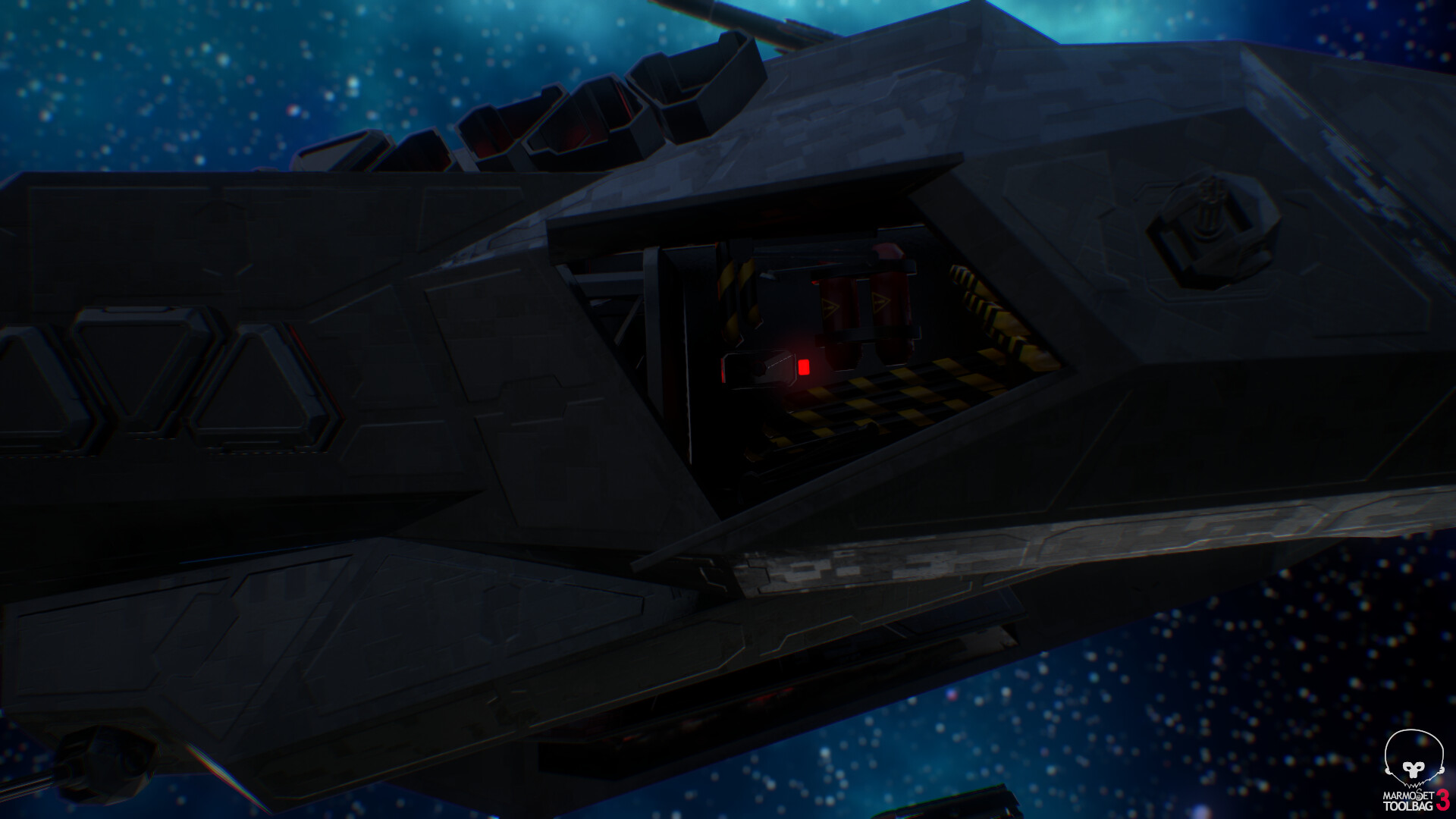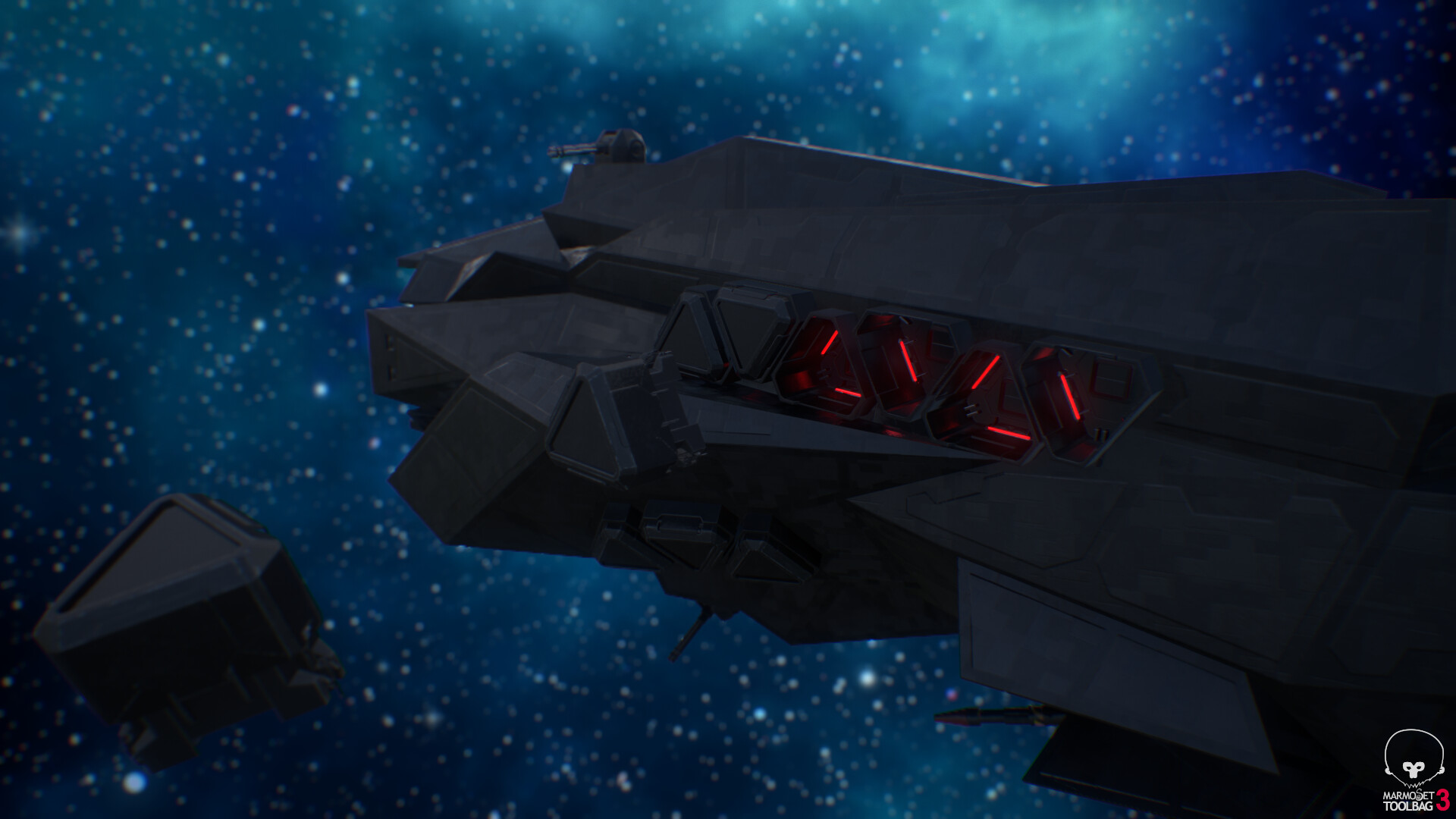Shuklaar Kyrdol
CEO of Breshig War Forge Consolidated



(Seen on a commissioned stealth test bed.)
OUT OF CHARACTER INFORMATION
- Intent: To create a modular drop/boarding pod bay for use in installations and ships of varying tonnages by Breshig War Forge Consolidated, Strill Securities and select others.
- Image Source: Here.
- Canon Link: N/A.
- Permissions: N/A.
- Primary Source: N/A.
PRODUCTION INFORMATION
- Manufacturer: Breshig War Forge Consolidated.
- Affiliation: Breshig War Forge Consolidated and Strill Securities.
- Market Status: Closed-Market.
- Model: 'Heyr'latr Morut' Modular Drop/Boarding Pod Bay.
- Modularity: Can be scaled up or down to be fitted into most starships larger than 30 meters, installations and stations.
- Production: Minor.
- Material:
- Material:
- Blast shield:
- Turadium frame
- Duravlex exterior
- Condensed-matter composite reinforcement
- Cyroban cooling lattice
- Crash net:
- Other components:
- Combat de-ionizer(s)
- Cap Drain
- Ultrachrome wiring, circuitry and electronics.
- Export model:
- Bay structure:
- Molecularly bonded Duranium frame
- Molecularly bonded Duranium-reinforced Duraplast composite plating
- Condensed-matter composite reinforcements
- Agrinium lining
- Thermal gel lining
- Anti-corr coating
- Blast door:
- Turadium frame
- Agrinium lining
- Thermal gel lining
- Molecularly bonded Duranium-reinforced Duraplast composite plating
- Anti-corr coating
- Bay structure:
- Mandalorian customer and internal model:
- Bay structure:
- Stesr'gar frame
- Stesr'gar-reinforced Duraplast composite palting
- Condensed-matter composite reinforcements
- Agrinium lining
- Thermal gel lining
- Anti-corr coating
- Blast door:
- Turadium frame
- Agrinium lining
- Thermal gel lining
- Stesr'gar-reinforced Duraplast composite plating
- Anti-corr coating
- Bay structure:
- Blast shield:
- Material:
SPECIAL FEATURES
- Launch Tubes:
- Pod Adapter: The launch tubes come with an adaptor for launching pods that are smaller than the tube.
- Catapult pressor beam projector(s): Catapult pressor beam launchers allow for increased launch velocity of pods. This also increases the launch rate of pods, by allowing pods to clear the launch tubes faster.
- Retractable engine blast shield(s): Allows fighter craft to launch with their engines on full without causing damage to anything behind the pod's drive.
- Automatically sealing blast doors with manual override.
- Magnetic fields with backup.
- Recovery Bay:
- Precision tractor beam projector(s): Precision tractor beam projectors allow tractor assisted recovery of pods, as well as the easier capture of fleeing vessels.
- Retractable emergency crash net(s): When tractor recovery is not possible, proving to be ineffective, a crash net can be erected to arrest an incoming craft's momentum.
- Repair/Re-arm/Maintenance Station(s)
- 'Iu'yaniyasa Ga'napr' Automated Modular Foundry integration: Spare parts are manufactured by the automated foundry system and send to each station in advance, though parts can also be manufactured and dispatched on demand, though this will take time.
- 'Iu'yaniyasa Larda' Automated Ammunition Handling System integration: Ammunition for the pod is stored in the loading bay, but can also be sent on demand by the company's automated ammunition handling system, if present.
- 4x MCD-01 Gar'gotabor Maintenance/Construction Droid: Each station is attended to by four Gar'gotabor droids who can be programmed with the schematics of whatever pods are usually stored in the bay. They attend to repairs, maintenance and re-arming of the craft either autonomously or under the supervision of an organic or droid crew member.
- Automatically sealing blast door with manual override.
- Magnetic field with backup.
- Loading Bay:
- Identichip secured Ammunition Locker: Spare ammunition can be logged and stored in ammunition lockers in the bay. If the company's automated ammunition handling system
- Spare Turret(s) (Chekar or similar pods): For use in Chekar boarding pods or similar, additional Cabur automated turrets are stored in the loading bay.
- Life Support:
- Mounting platform's life support system: The bay can make use of the mounting platform's life support systems (usually) without any modifications.
- Redundant 'Btare Ar' Life Support System: In the event that the mounting platform doesn't have any life support systems, or they've become compromised, the system features a redundant life support system of its own.
STRENGTHS
- Stackable: The triangular shaped tubes allow for a higher number of tubes to be fitted in a given area than a square or hexagonal design.
- High Degree of Automation: The high degree of automation reduces crew requirements and fatigue, freeing up crew for more critical tasks.
- Easy Launch, Recovery and Maintenance: The bay allows for a very streamlined and painless launch, recovery and maintenance of pods, thanks to the myriad automated and computer assisted systems.
- Pod Adapter: The pod adapter allows pods smaller than the Chekar-class Boarding/Drop Pod to be fielded.
WEAKNESSES
- Size: The tubes are made to launch the B/DP-01M Chekar-class Boarding/Drop Pod, and can only launch pods that are exactly it's dimensions or small enough to fit into the adapter.
- It's a Drop Pod Bay: The bay itself offers no direct offensive or defensive benefit to the mounting platform and the pods themselves are hardly likely to be more useful than a starfighter in a direct capacity.
- Close the Blast Doors: Should the bay's magnetic field and backup fail, then the blast doors will automatically begin the sealing process. In such an event, any craft not already inside will be locked out and those not launched will be unable to do so till the blast doors' manual override is engaged.
- High Degree of Automation: While freeing up the crew's attention for more critical tasks, the high degree of automation means that there's a lot of Ion/EMP vulnerable equipment in the hangar.
DESCRIPTION
Like the other modular systems manufactured by the company, the Heyr'latr Morut was designed to reduce the amount of variance in component design on warships for ease of manufacturing, maintenance, training and so on. The company's only produced boarding/drop pod is the B/DP-01M Chekar, and as a result there was a push to build the bay and launch tubes around the Chekar given the lack of demand from customers for dramatically different pods. The Chekar's design allowed more pods to be fitted in a given area, which was another reason the company decided to stick with the triangular pod launch tubes. For pods smaller than the Chekar, a pod adapter is included, however pods that are larger or of significantly differing dimensions will not fit into the adapter.
Like the modular hangar and deployment bay, the Heyr'latr Morut's high degree of automation reduces the crew requirements, allowing the bay to be minimally or even entirely unstaffed. Pods can be launched and retrieved entirely automatically with only limited interaction required from the pod's passengers/crew. When crewed, the launch, recovery and maintenance process is extremely streamlined thanks to the myriad automated and computer assisted systems. That said, the high degree of automation does increase the system's vulnerability to EMP/Ion damage due to the amount of albeit well protected electronics. The same automation has a further disadvantage when it comes to safety features, as the blast doors will automatically seal when loss of pressure is detected (usually from failure of the magnetic seal), requiring crews to engage the manual override before pods can be retrieved or launched once more.






